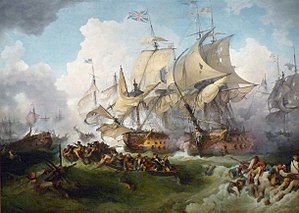
HMS Theseus was a 74-gun third-rate ship of the line of the Royal Navy.

HMS Lion was a 64-gun third-rate ship of the line of the Royal Navy, of the Worcester class, launched on 3 September 1777 at Portsmouth Dockyard.
HMS Ganges was a 74-gun third-rate ship of the line of the Royal Navy, launched in 1782 at Rotherhithe. She was the first ship of the Navy to bear the name, and was the name ship of her class. She saw active service from 1782 to 1811, in Europe and the West Indies.

HMS Agamemnon was a 64-gun third-rate ship of the line of the British Royal Navy. She saw service in the American Revolutionary War, French Revolutionary and Napoleonic Wars, and fought in many of the major naval battles of those conflicts. She is remembered as being Nelson's favourite ship, and was named after the mythical ancient Greek king Agamemnon, being the first ship of the Royal Navy to bear the name.

HMS Neptune was a 98-gun second-rate ship of the line of the Royal Navy. She served on a number of stations during the French Revolutionary and Napoleonic Wars and was present at the Battle of Trafalgar in 1805.

HMS Boyne was a 98-gun Royal Navy second-rate ship of the line launched on 27 July 1790 at Woolwich. She was the flagship of Vice Admiral John Jervis in 1794. She caught fire and blew up in 1795.

HMS Hannibal was a 74-gun third-rate ship of the line of the Royal Navy, launched on 15 April 1786, named after the Carthaginian general Hannibal. She is best known for having taken part in the Algeciras Campaign, and for having run aground during the First Battle of Algeciras on 5 July 1801, which resulted in her capture. She then served in the French Navy until she was broken up in 1824.
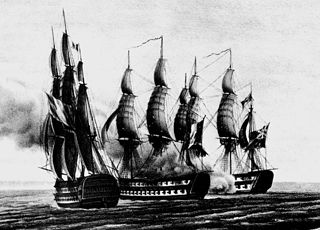
HMS Swiftsure was a 74-gun third rate ship of the line of the British Royal Navy. She spent most of her career serving with the British, except for a brief period when she was captured by the French during the Napoleonic Wars in the action of 24 June 1801. She fought in several of the most famous engagements of the French Revolutionary and Napoleonic Wars, fighting for the British at the Battle of the Nile, and the French at the Battle of Trafalgar.

HMS Foudroyant was an 80-gun third rate of the Royal Navy, one of only two British-built 80-gun ships of the period. Foudroyant was built in the dockyard at Plymouth Dock and launched on 31 March 1798. Foudroyant served Nelson as his flagship from 6 June 1799 until the end of June 1800.
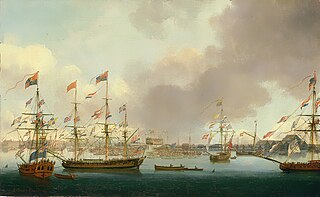
HMS Alexander was a 74-gun third-rate of the Royal Navy. She was launched at Deptford Dockyard on 8 October 1778. During her career she was captured by the French, and later recaptured by the British. She fought at the Nile in 1798, and was broken up in 1819. She was named after Alexander the Great.
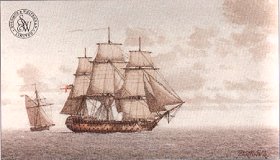
HMS Edgar was a 74-gun third-rate ship of the line of the Royal Navy, that saw service in the American Revolutionary, French Revolutionary and Napoleonic Wars. Launched in 1779, she fought in the battles of Cape St Vincent and Copenhagen, two of the major naval engagements of the wars.
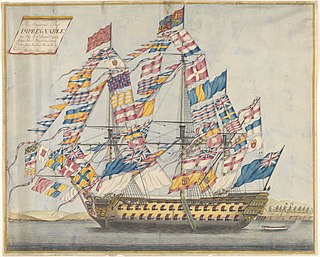
HMS Impregnable was a Royal Navy 98-gun second rate ship of the line launched on 15 April 1786 at Deptford Dockyard. She was wrecked in 1799 off Spithead.

HMS Alcide, the French and Italian version of "Alcides", another name for Heracles, was a 74-gun third-rate ship of the line of the Royal Navy, designed by Sir Thomas Slade and built by Adam Hayes at Deptford Dockyard being launched on 30 July 1779.

HMS Director was a 64-gun third rate ship of the line of the Royal Navy, launched on 9 March 1784 at Gravesend. She was laid down speculatively in November 1779, and ordered by the Navy the following year.

HMS Cambridge was an 80-gun third-rate ship of the line of the Royal Navy, designed by Sir Joseph Allin and built at Deptford Dockyard by Adam Hayes to the draught specified by the 1745 Establishment as amended in 1750, and launched on 21 October 1755.
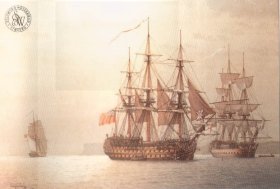
HMS Glory was a 98-gun second-rate ship of the line of the Royal Navy, launched on 5 July 1788 at Plymouth.

HMS Atlas was a 98-gun second-rate ship of the line of the Royal Navy, launched on 13 February 1782. She was a Duke-class ship of the line built at Chatham Dockyard by Nicholas Phillips.

HMS Caesar, also Cæsar, was an 80-gun third rate ship of the line of the Royal Navy, launched on 16 November 1793 at Plymouth. She was designed by Sir Edward Hunt, and was the only ship built to her draught. She was also one of only two British-built 80-gun ships of the period, the other being HMS Foudroyant.

HMS Ardent was a 64–gun third-rate ship of the line of the Royal Navy, launched on 9 April 1796 at Northfleet. She had been designed and laid down for the British East India Company who was going to name her Princess Royal, but the Navy purchased her before launching, for service as a warship in the French Revolutionary War.
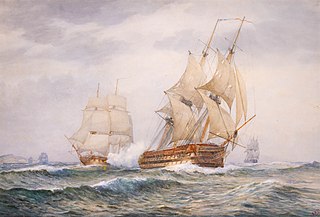
The Battle of the Malta Convoy was a naval engagement of the French Revolutionary Wars fought on 18 February 1800 during the Siege of Malta. The French garrison at the city of Valletta in Malta had been under siege for eighteen months, blockaded on the landward side by a combined force of British, Portuguese and irregular Maltese forces and from the sea by a Royal Navy squadron under the overall command of Lord Nelson from his base at Palermo on Sicily. In February 1800, the Neapolitan government replaced the Portuguese troops with their own forces and the soldiers were convoyed to Malta by Nelson and Lord Keith, arriving on 17 February. The French garrison was by early 1800 suffering from severe food shortages, and in a desperate effort to retain the garrison's effectiveness a convoy was arranged at Toulon, carrying food, armaments and reinforcements for Valletta under Contre-amiral Jean-Baptiste Perrée. On 17 February, the French convoy approached Malta from the southeast, hoping to pass along the shoreline and evade the British blockade squadron.
